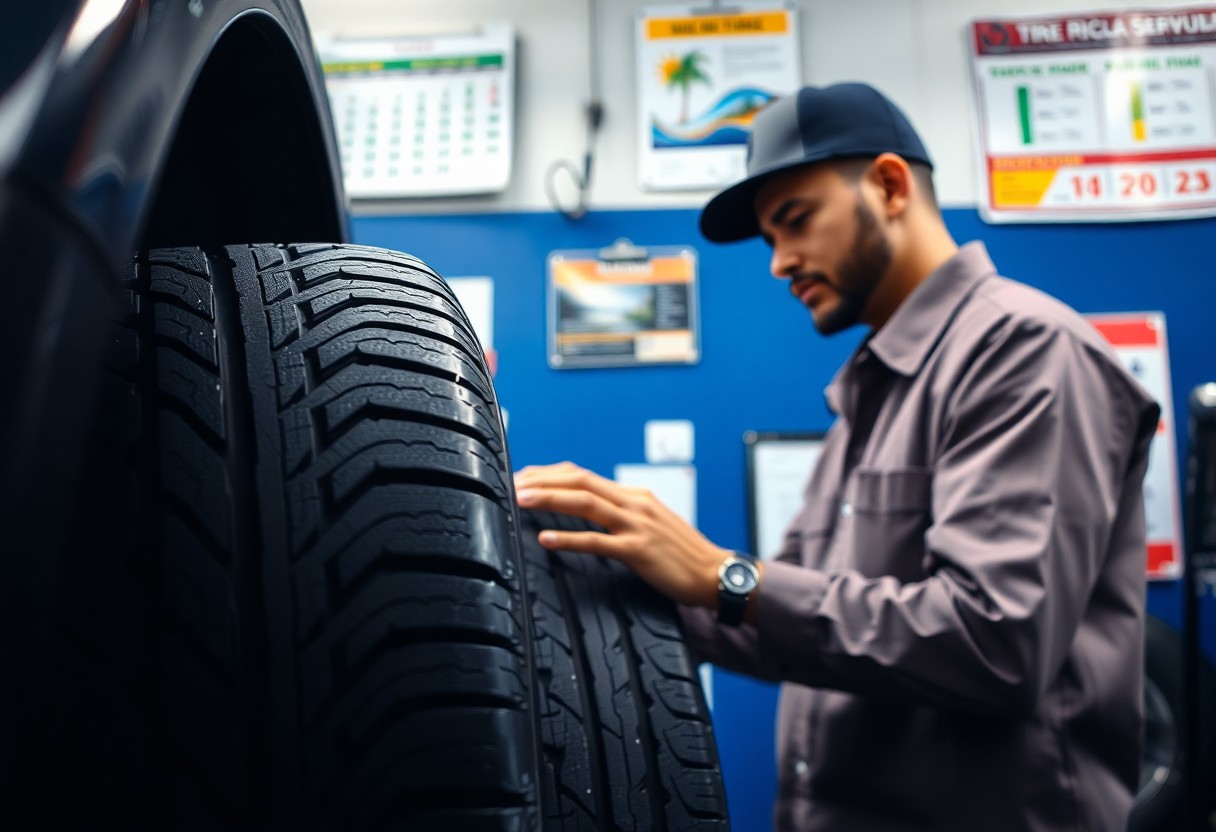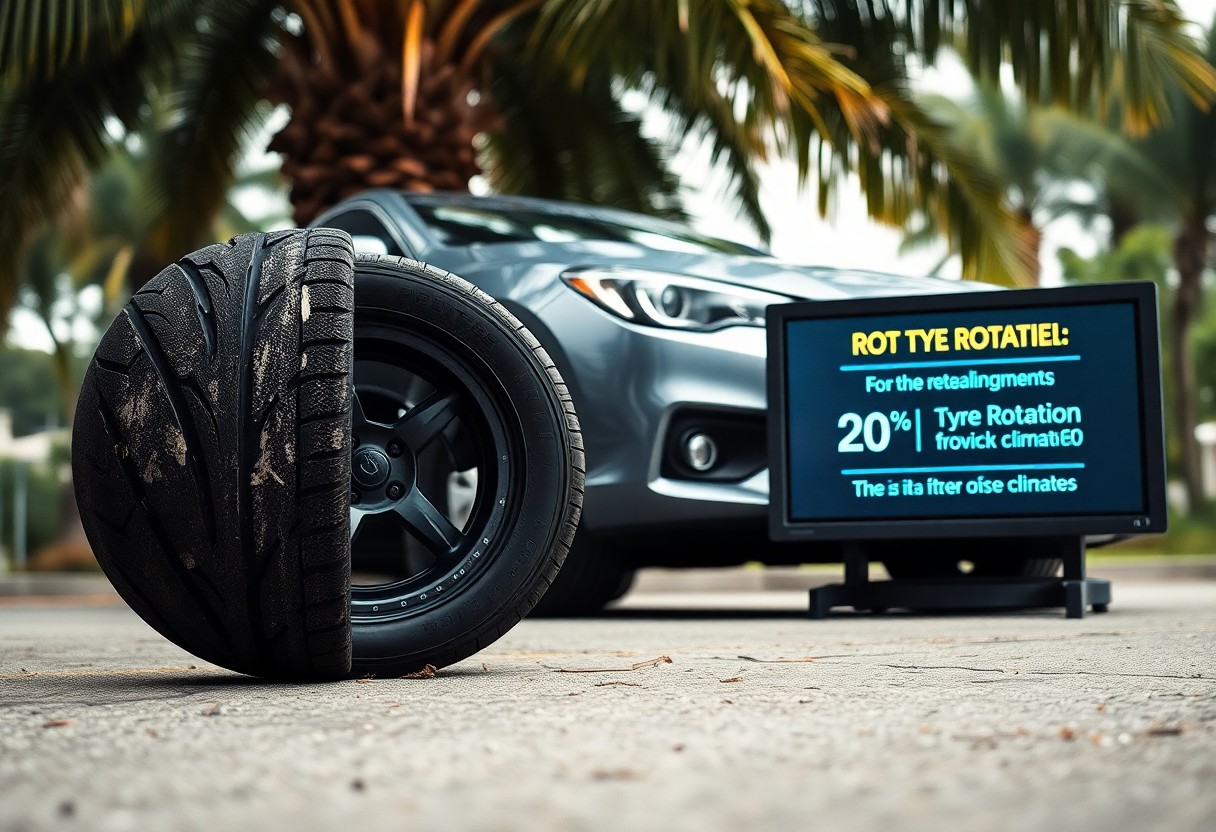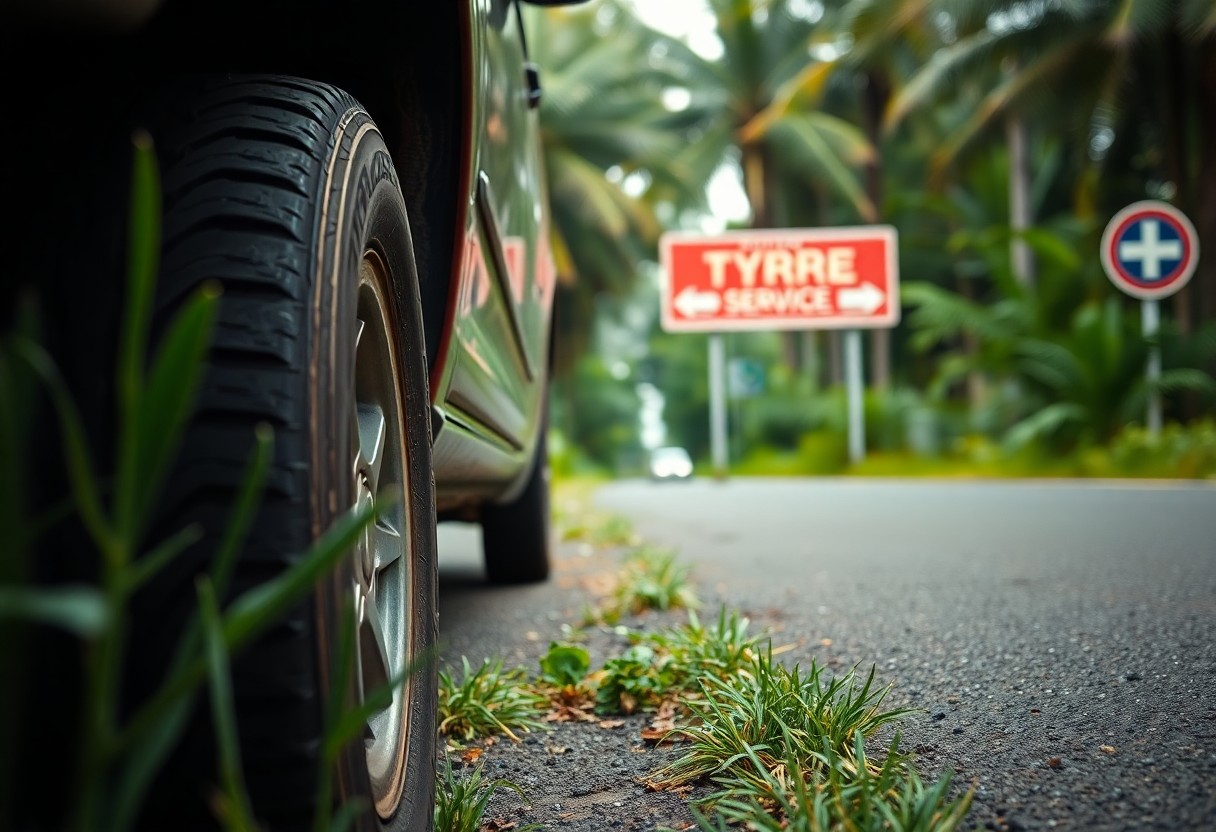Most car owners in Klang may overlook the importance of regular tyre rotation in the region’s tropical climate, which can lead to uneven wear and potentially dangerous driving conditions. To maintain optimal tyre performance and ensure your safety on the road, it’s recommended that you rotate your tyres every 5,000 to 8,000 kilometers or at least during every other oil change. By following this guideline, you not only extend the life of your tyres, but also enhance your overall driving experience in the heat and humidity of Klang.
Key Takeaways:
- Rotate tyres every 5,000 to 10,000 kilometers to ensure even wear.
- In tropical climates like Klang, increased heat can accelerate tyre degradation.
- Consider rotating tyres with each oil change for convenient maintenance.
- Monitor tread depth and tyre pressure regularly, as environmental conditions can affect performance.
- All-wheel drive vehicles may require rotations more frequently than front or rear-wheel drives.
- Consult vehicle manufacturer guidelines for specific rotation patterns tailored to your car’s design.
- Proper tyre rotation enhances safety, fuel efficiency, and extends the lifespan of your tyres.
The Impact of Klang’s Weather on Tyre Longevity
Klang’s tropical climate plays a significant role in the lifespan of your tyres. The persistent heat and humidity create conditions that accelerate wear and tear, making it vital to monitor your tyres closely. As temperatures soar, the integrity of the rubber compounds in tyres may degrade faster than in cooler climates, directly impacting their performance and safety. This means that regular inspections and timely rotations become increasingly important for drivers in Klang to maintain optimal handling and traction.
Humidity’s Role in Tyre Wear
High humidity levels in Klang contribute to tyre degradation by fostering conditions conducive to moisture accumulation. This moisture can lead to the development of rust and corrosion on wheels, ultimately compromising your tyres’ structural integrity. Additionally, prolonged exposure to humid conditions may cause uneven wear, requiring you to be vigilant about checking for signs of damage and wear patterns.
The Influence of Tropical Heat on Tyre Composition
The intense heat in Klang affects the chemical properties of tyre materials, leading to faster decomposition. This can result in a reduction of vital compounds that provide flexibility and strength. Over time, excessive heat exposure can lead to a condition known as “hardening” of the rubber, which detracts from its grip on the road. Implementing a regular rotation schedule can help mitigate this issue by ensuring even wear across all tyres.
The phenomenon known as “tyre hardening” occurs due to high temperatures breaking down the polymers within the tyre’s rubber composition, particularly in high-performance models. As these polymers degrade, you may notice your tyres losing their ability to provide adequate traction and responsiveness on wet surfaces. In Klang’s tropical climate, where temperatures can exceed 30°C regularly, drivers can experience a significant drop in tyre life if they do not follow proper maintenance routines. Regular checks are vital to avoid unexpected blowouts and ensure maximum performance during emergency situations.

Signs Indicating the Need for Tyre Rotation
Detecting signs that your tyres require rotation can prolong their lifespan and enhance vehicle performance. Look for uneven tread wear patterns—where one side of the tyre is significantly more worn than the other—as this indicates that it’s time for a change. If you experience vibrations while driving or notice your vehicle pulling to one side, these symptoms may also suggest misalignment linked to tyre wear. Keeping an eye out for these signs allows you to address issues before they escalate and impact your safety on the road.
Uneven Wear: What to Look Out For
Uneven wear can manifest as bald patches or uneven tread depth across your tyres. Check for differences in tread wear between the front and rear tyres, as well as side-to-side discrepancies. If you notice that the inner or outer edges of your tyres are wearing down faster than the rest, this indicates abnormal wear patterns that require urgent attention. Regular inspections can help you avoid dangerous blowouts and maintain your vehicle’s traction and handling capabilities.
The Importance of Regular Inspections
Scheduling regular inspections can help you catch tyre issues early and avoid unexpected expenses. Frequent checks should include assessing tyre pressure, inspecting tread depth, and scrutinizing for cuts, punctures, or other damages. In Klang’s unpredictable climate, the combination of heat and rain can exacerbate wear and tear, making it vital to ensure that your tyres are in optimum condition. By committing to these inspections, you can not only extend the life of your tyres but also enhance your overall driving safety.
A detailed examination of your tyres can reveal crucial information about their overall health. For instance, you might notice a difference in tyre pressure, which can directly impact fuel efficiency and handling. Keeping an eye on tread depth not only helps with scheduling rotations but ensures that your tyres meet legal standards for safe driving. With the harsh elements in Klang, regular inspections are not just a recommended best practice but a common-sense approach to staying safe on the road. By taking the time to address these aspects, you significantly mitigate the risk of malfunctions and maintain the reliability of your vehicle.

Recommended Rotation Frequency for Different Driving Conditions
Your driving habits significantly influence how often you should rotate your tyres. Since Klang’s road conditions and weather vary, adjusting your maintenance schedule based on your specific circumstances can enhance tyre performance and safety.
City Driving vs. Highway Driving
Driving predominantly in the city usually subjects your tyres to more frequent stops, turns, and more wear on the outer edges. In contrast, highway driving predominantly involves steady speeds and less directional change, leading to more uniform tyre wear. For city driving, consider rotating your tyres every 5,000 kilometers, while those primarily driving on highways may extend the interval to 10,000 kilometers.
Heavy Loads and Off-Road Considerations
Transporting heavy loads or venturing off-road can accelerate tyre wear due to increased stress and heat. If you often carry substantial loads or take your vehicle on rugged terrains, plan for more frequent rotations, ideally every 3,500 to 5,000 kilometers, to ensure even wear and optimal performance.
Heavy loads exert extra pressure on your tyres, increasing the likelihood of uneven wear. Off-road conditions can introduce additional challenges, such as rocks and uneven surfaces that may lead to premature tyre damage. Regularly rotating tyres in these situations not only prevents significant wear but also optimizes traction and handling capabilities. Keeping an eye on tyre condition and adjusting rotation frequency based on your driving patterns will keep your vehicle safe and extend the lifespan of your tyres.
Seasonal Adjustments for Tyre Care
Your tyre maintenance strategy should adapt to the changing seasons, especially in Klang. The extreme humidity and heat can modify how your tyres perform, prompting you to take specific steps to ensure optimal safety and longevity all year round.
Preparing for Rainy Seasons
Best Practices During Hot Season

Expert Tips to Extend Tyre Life in Humid Climates
- Regular rotation every 5,000 to 8,000 km
- Prioritize proper inflation and pressure monitoring
- Choose tyres designed for tropical conditions
- Maintain a clean tyre surface to prevent debris build-up
- Avoid sudden braking and acceleration to reduce wear
Assume that you want to maximise your tyre lifespan while navigating Klang’s tropical environment. Regular checks, along with being mindful of your driving habits, can significantly enhance your tyres’ durability.
Proper Inflation and Pressure Monitoring
Maintaining the right tyre pressure is crucial in humid climates to ensure optimal performance and longevity. Underinflated tyres wear unevenly and increase heat generation, risking blowouts. Regularly check tyre pressure, ideally once a month and before long trips, and adjust according to your vehicle’s specifications.
Choosing the Right Tyre for Tropical Conditions
Your choice of tyres plays a significant role in how well they withstand the challenges of Klang’s humid weather. Tyres designed for wet conditions, marked with appropriate tread patterns for grip and water displacement, will enhance safety during rain. Look for tyres with robust sidewalls to resist punctures from debris commonly found in tropical regions.
Choosing the right tyre goes beyond tread design; consider compounds that offer better heat resistance and overall durability. For instance, tyres with a softer rubber compound can provide improved traction in wet conditions but may wear faster in hotter climates. Brands that specifically cite tropical expertise in their product lines often feature enhanced warranties or performance guarantees, which can be reassuring as you make your selection.
Conclusion
As a reminder, in Klang’s tropical climate, it’s crucial to rotate your tyres every 5,000 to 10,000 kilometers or at least during every second oil change. This regular maintenance helps ensure even tread wear and enhances your vehicle’s performance and safety. By paying attention to your tyre rotation schedule, you can extend the life of your tyres and improve the overall driving experience. Make it a habit to check and maintain proper tyre health, so you can enjoy a safer ride in the often hot and humid weather of your area.
FAQ: How Often to Rotate Tyres in Klang’s Tropical Climate
Q: What factors influence how often I should rotate my tyres in Klang’s tropical climate?
A: The primary factors include road conditions, driving habits, tyre brand and type, and climate factors such as temperature and rainfall. In tropical climates like Klang, frequent rain can lead to a slick road surface, which may cause uneven tyre wear if not monitored. Regular rotation can help manage this.
Q: How often should I rotate my tyres in Klang?
A: It is generally recommended to rotate your tyres every 5,000 to 8,000 kilometers driven. However, due to the specific conditions of Klang’s climate, including heat and rain, you might consider checking them more often, especially if you notice uneven wear.
Q: Is it important to follow the car manufacturer’s recommendations for tyre rotation?
A: Yes, adhering to the car manufacturer’s guidelines for tyre rotation is advisable as they understand the specific dynamics and weight distribution of your vehicle. Their recommendations are designed to ensure optimum performance and safety, taking into account the climate and typical driving conditions.
Q: What signs indicate that it’s time to rotate my tyres?
A: Look out for signs like uneven tread wear (one side tread more worn), vibrations while driving, or decreased traction on wet roads. If you notice any of these signs, it’s a good idea to rotate your tyres before the recommended interval.
Q: Can I rotate my tyres myself or should I go to a professional?
A: While you can rotate your tyres yourself if you have the necessary tools and knowledge, seeking a professional can ensure it’s done correctly. Tyre professionals can also check for other issues like alignment and suspension problems that may affect tyre wear.
Q: How do road conditions in Klang affect tyre wear?
A: In Klang, the combination of hot weather and heavy rains can lead to different road conditions, from dry asphalt to wet surfaces with standing water. These conditions can cause uneven wear if not managed with regular tyre rotation, making it important to keep an eye on your tyre health.
Q: What should I do if I notice premature tyre wear?
A: If you notice premature tyre wear, inspect your tyres for alignment issues, unbalanced wheels, or improper inflation. It’s also a good idea to have a professional check them out for any underlying issues and consider rotating them more frequently based on your driving style and conditions.
